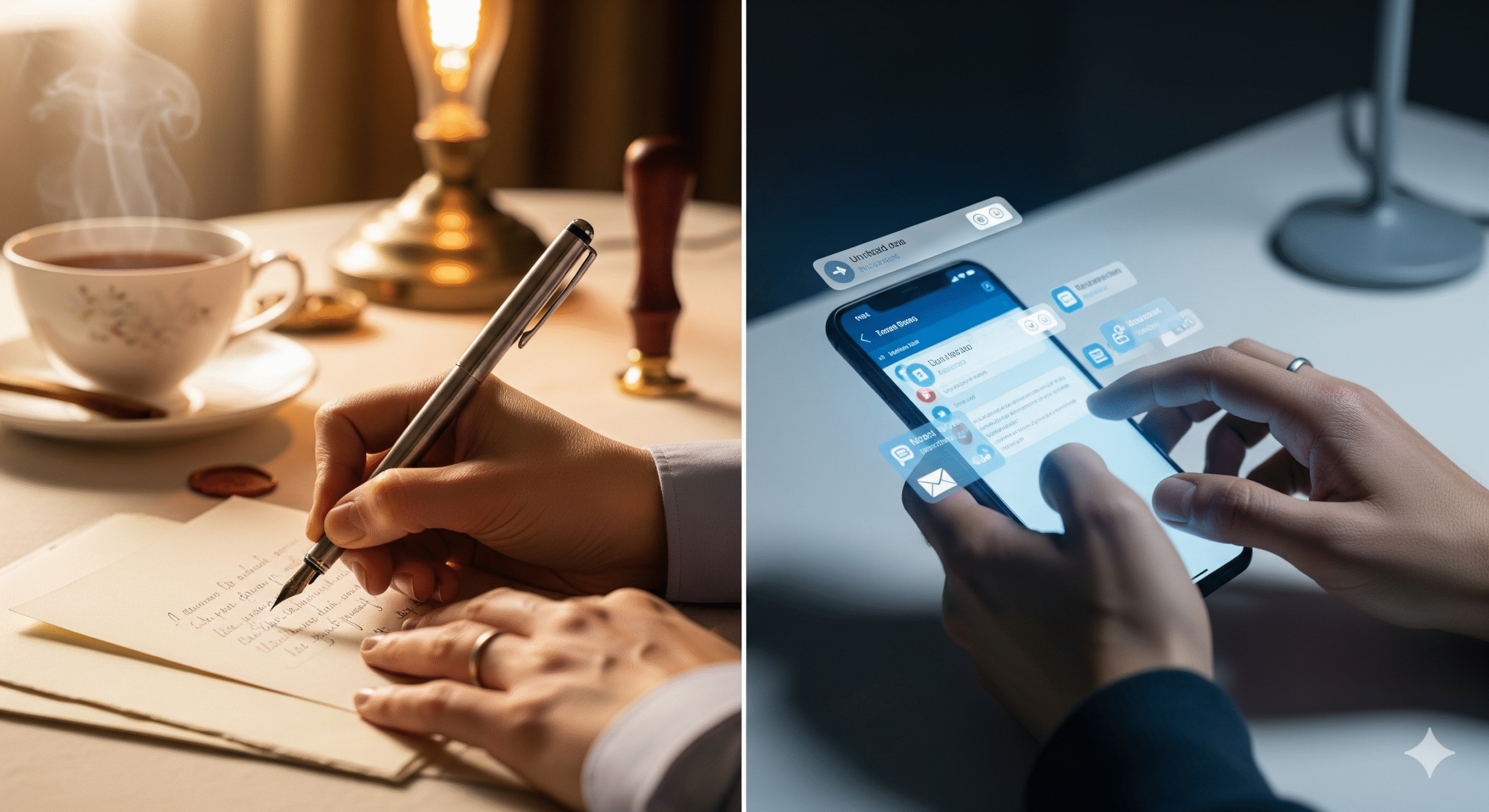For centuries, letter writing was the lifeblood of society. It was the primary way people communicated across distances, shared news, built relationships, and conducted business. From the love letters of poets and the philosophical musings of great thinkers to the desperate missives sent from battlefields, letters have shaped history, preserved culture, and kept families connected across continents.
The act of writing a letter was a ritual. It required patience and a deliberate choice of words. Without the ability to instantly delete and rewrite, a writer had to think carefully, organize their thoughts, and craft a coherent narrative. The correspondence between two people was a physical record of their relationship, a tangible archive of their thoughts, feelings, and the passage of time.
The slow, methodical nature of letter writing shaped how we communicated. It encouraged deep thought, reflection, and a sense of permanence. When a letter was sent, the writer had to wait, sometimes for weeks or months, for a reply. This waiting period fostered a unique kind of anticipation and an appreciation for the moment when a response finally arrived.
The advent of the telephone in the early 20th century began the decline, but the true revolution—and the subsequent “forgetting”—began with the rise of the internet. Email, instant messaging, and text messages promised to eliminate time and distance, offering a level of connectivity that was previously unimaginable. While this has brought incredible benefits, it has also stripped away the very elements that made letter writing so powerful.
A Tale of Two Communications: The Hand-Written vs. The Digital
On the surface, digital communication seems to win every category. It’s faster, cheaper, and more convenient. But when you look deeper, you realize that the slow, deliberate nature of letter writing provides a different, and perhaps more valuable, set of benefits.
| Trait | Letter Writing (Hand-Written) | Digital Communication (Email, Text) |
| Speed & Convenience | Slow & Deliberate. Requires time, thought, and physical effort. Subject to postal delays. | Instant & Effortless. A message can be sent and received in seconds. |
| Emotional Impact | Profound & Personal. The physical, unique nature of a handwritten letter conveys a deep level of care and intention. It is a tangible memento. | Fleeting & Impersonal. Messages are often mass-produced and lack a physical presence. They are quickly forgotten or deleted. |
| Mindfulness | High. Requires focus and attention, encouraging a thoughtful and reflective state of mind. It is a break from digital distraction. | Low. Often done in a hurry, multitasking, or impulsively. Can contribute to digital burnout. |
| Permanence | Permanent. A letter is a physical object that can be held, cherished, and kept for a lifetime, becoming a historical record. | Ephemeral. A digital message is a string of data that is easily lost, deleted, or forgotten. |
| Authenticity | Authentic. A person’s unique handwriting and writing style are a part of the communication. It cannot be easily replicated. | Uniform. All messages look the same, regardless of who writes them. |
| Privacy | Secure (Relatively). A letter is a private object. While it could be read by others, it cannot be as easily hacked or stored on a server for data mining. | Vulnerable. Digital communication is subject to hacking, corporate data collection, and government surveillance. |
Export to Sheets
This comparison highlights a critical difference: digital communication is a tool for information exchange, while letter writing is a medium for emotional connection. The former is about efficiency; the latter is about humanity.
The Key Features of a Handwritten Letter
The enduring power of a handwritten letter lies in its unique characteristics—the very qualities that digital communication cannot replicate.
1. The Power of Intentionality and Presence
In a world where we can multitask in a thousand different ways, letter writing is an act of pure presence. It requires a dedicated block of time, a quiet space, and a focused mind. You cannot write a thoughtful letter while simultaneously scrolling through social media. This intentionality is a gift to both the writer and the recipient. For the writer, it is a form of active mindfulness. For the recipient, it signals that they are important enough to command the writer’s full attention.
2. A Tangible Token of Affection
A letter is a physical object that a person can hold in their hands, place on a desk, or put away in a box of memories. It is a tangible piece of proof that you were in someone’s thoughts. This physicality is incredibly powerful. A text message or email, no matter how heartfelt, can never carry the same weight as a handwritten letter. It’s a memento that you can return to, a reminder of a specific time and a person’s feelings.
3. A Medium for Deep, Unfiltered Thought
The slow pace of letter writing encourages a different kind of communication. Without the pressure of an instant reply, you have time to organize your thoughts, reflect on your feelings, and articulate them with greater clarity and depth. This process can be therapeutic, helping you understand your own emotions and experiences. It allows for a more personal and vulnerable form of self-expression than a rushed text message ever could.
4. An Improvement in Communication Skills
In an age of abbreviations, emojis, and auto-correct, our writing skills are in decline. The practice of letter writing forces you to use proper grammar, structure a coherent argument, and find the right words to convey your message. This deliberate practice improves your communication skills in a way that texting never can, making you a more articulate and thoughtful communicator in all aspects of your life.
The Pros and Cons: A Balanced View
While this article is a passionate defense of letter writing, a balanced perspective is essential. The practice has its own set of undeniable drawbacks.
Pros:
- Deeper Connection: It builds a more profound and lasting bond than digital communication.
- Therapeutic and Mindful: The act of writing is a meditative practice that reduces stress and promotes self-reflection.
- A Lasting Memento: A letter is a tangible historical record that can be cherished for years, unlike a digital message.
- Uniqueness: It shows a high level of effort and care that is a rare and valued commodity in the digital world.
- True Privacy: A letter is a private object between two people, free from the data collection and corporate surveillance that plagues digital platforms.
Cons:
- Lack of Speed: It is incredibly slow and unsuitable for urgent communication or a quick check-in.
- Logistical Effort: It requires time to write, find a stamp, and get to a mailbox—a barrier that instant messaging has eliminated.
- Risk of Loss: A letter can be lost in the mail, whereas a digital message can often be verified as received.
- Cost: Paper, envelopes, and stamps all have a cost, whereas most digital communication is free.
Use Cases: Why You Should Start Writing Letters Today
While not a replacement for digital communication, letter writing is a powerful tool for specific, high-impact scenarios. Reviving this habit can significantly enrich your relationships and personal life.
- Thank You Notes: A handwritten thank you note after a job interview, a gift, or a kind gesture carries an immense weight of sincerity that an email can never match. It shows you genuinely appreciate the person’s time and effort.
- Apologies and Condolences: In moments of deep emotion, a handwritten letter provides the sincerity and gravity that a text or even a phone call might lack. A letter of condolence, for instance, can be a cherished memento that a person can hold onto in their time of grief.
- Building a Relationship with Loved Ones: Writing a letter to a parent, sibling, or close friend can be a deeply rewarding experience. It’s a way to express feelings you might not feel comfortable saying aloud and to create a lasting memory of your bond.
- For Yourself (Journaling): While not technically a letter to someone else, the act of writing by hand in a journal or a series of letters to your future self is a powerful form of self-reflection and personal growth. It allows you to process your thoughts in a way that typing cannot replicate.
- For Professionals: In a sea of digital correspondence, a handwritten note to a client, a mentor, or a potential employer will make you stand out and create a lasting, positive impression.
FAQs: Your Questions on Letter Writing Answered
Is letter writing really a lost art?
While its use has declined dramatically for daily communication, letter writing is experiencing a resurgence as a niche practice. Many people are discovering its benefits for personal connection, mindfulness, and as a way to stand out in a digital-first world.
What are the mental and psychological benefits of writing letters?
The act of writing by hand stimulates parts of the brain related to memory and learning. It also encourages a more mindful, reflective state, which can help reduce stress and anxiety. The physical act of writing is a therapeutic process that helps organize and clarify thoughts and feelings.
How can I start a letter writing habit?
Start small! Commit to writing one letter a week or even one a month. Buy some nice stationery, find a comfortable place, and choose one person to write to. Don’t worry about being perfect; just focus on being honest and from the heart.
Is it okay to send a handwritten letter instead of an email?
For formal or time-sensitive communication, an email is still the standard. However, for expressing gratitude, condolences, or simply a desire to connect on a deeper level, a handwritten letter is not only okay—it is often a far more impactful and appreciated gesture.
How do I find a pen pal to start writing letters?
There are many online communities and websites dedicated to connecting people who want to practice letter writing. A simple search for “pen pal websites” or “letter writing communities” can connect you with people from all over the world who share your interest.
Conclusion: A Rediscovery for the Soul
We live in a world that values speed above all else. We are rewarded for being the first to reply, the fastest to react, and the most productive in our communication. But the forgotten art of letter writing offers a powerful counter-narrative. It reminds us that some of the most profound human experiences cannot be rushed. It teaches us the value of patience, the beauty of a delayed response, and the power of a tangible connection in an intangible world.
Final Verdict: The digital age has not made letter writing obsolete; it has made it precious. While email and texting are indispensable tools for modern life, they can never replace the unique, emotional depth of a handwritten letter. The act of writing a letter is a gift of your most valuable resource: your time. And to the person who receives it, it is a reminder that in a world of endless noise, someone took the time to create a single, beautiful whisper just for them. It is a form of communication that is not just worth reviving—it is worth cherishing.







Leave a Reply